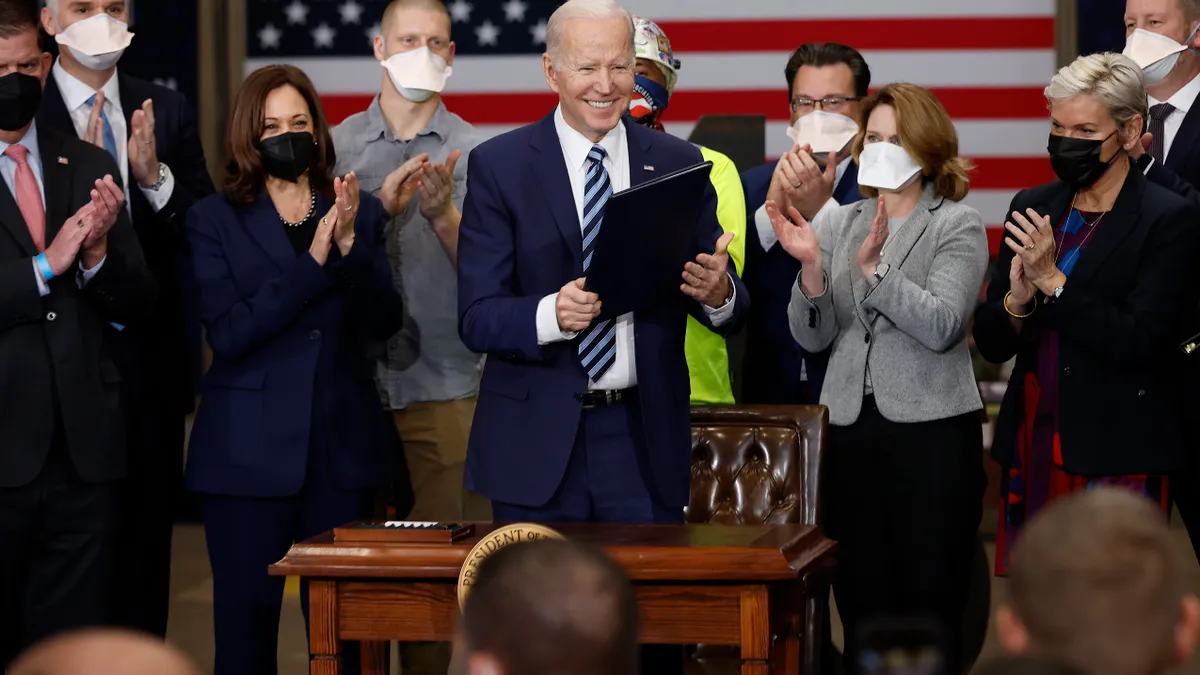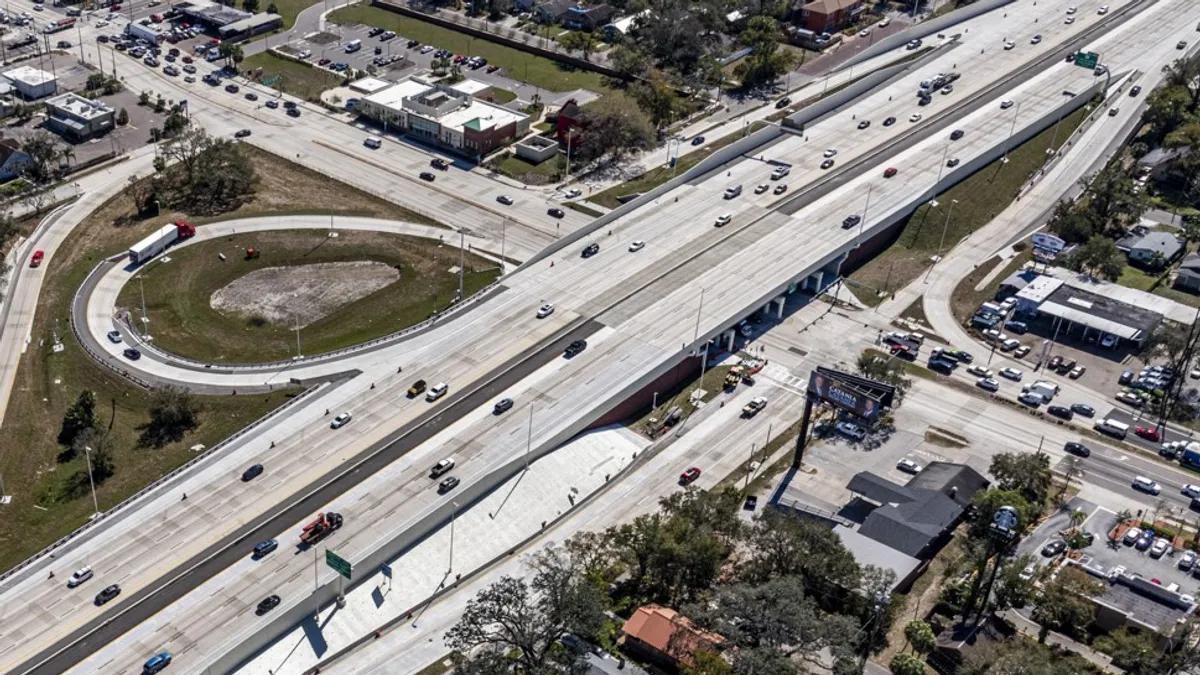With the stroke of a pen, President Joe Biden doubled down on his support of unions on federal construction projects.
On Feb. 4, Biden (pictured above at the signing) issued an executive order instituting a project labor agreement requirement on federal construction projects worth more than $35 million.
The move aligns with one of Biden's chief policies — strengthening unions at a time when membership in organized labor has declined for decades. Construction's union membership is higher than the nationwide average, but numbers still have steadily dropped since the 1970s.
The order coincides with the Infrastructure Investment and Jobs Act (IIJA), which will infuse billions in long-awaited spending for infrastructure projects and upgrades across the country. The White House predicts the order will affect $262 billion in federal contracts and impact nearly 200,000 workers.
"This helps projects get completed on time and helps the government get the best value for taxpayers' dollars," a White House statement said.
What is a PLA?
A PLA is similar to a collective bargaining agreement between a union and its employer, but differs in that it applies to a single project and is agreed upon by all parties: general contractors, subcontractors and labor groups.
Typically, the areas a PLA covers include:
- Wages and benefits.
- Apprenticeship and training programs.
- Jobsite rules, like alcohol and drug policies, harassment policies and break rules.
- Work hours and overtime.
- Jobsite safety.
A PLA will also cover procedures for resolving any employment disputes and prohibit strikes or work stoppages for the entirety of the agreement, Liz Cappiello, attorney for Washington, D.C.-based law firm Miller & Chevalier, told Construction Dive.
Typically, the GC and trade unions initially agree upon the PLA, under guidance from the agency or owner. Then other subcontractors agree to abide by the PLA when they join the project, according to Chris Bailey, attorney for St. Louis-based firm Greensfelder.
"A PLA will generally be in place before bidding on the project begins, so that contractors considering submitting their bids are aware of the requirements of the project," Bailey said.
In recent years, some public agencies have progressed toward Community Workforce Agreements (CWA), a specific type of PLA that promotes public policy, such as prioritizing training, employment or hiring of businesses run by women and minorities, Mark Johnson, labor relations consultant for Seattle-based labor consulting firm M. L. Johnson & Associates, told Construction Dive.
With the Biden order, some PLAs on these federal projects will also be CWAs, Johnson said.
What's in the executive order?
Labor groups say PLAs protect workers and prevent work stoppages to help deliver projects better, but builders and employer groups claim they disadvantage contractors that don't typically work with unions.
However, the executive order requires organizations to allow all contractors and subcontractors to compete for work, regardless of their collective bargaining experience, according to Cappiello.
"This executive order is not requiring you to be a union contractor, it's requiring you basically on a one-off basis to agree to a pre-hire collective bargaining agreement," said James Terry, partner at New York City construction law firm Zetlin & De Chiara.
Notably, only projects that receive money directly from federal procurement will fall under the executive order, meaning construction projects financed through grant dollars to non-federal organizations such as states will be exempt.
That doesn't mean, however, that other entities won't require PLAs, Terry said. Some agencies and groups can still require them on projects funded indirectly, or under the $35 million cost threshold.
"That would be a blue state inclination," Terry said of agencies requiring PLAs even when exempt.
It's still unclear whether the federal government will mandate uniform aspects of the PLAs, or if stakeholders will decide details on a project-by-project basis.
Getting ready
For a contractor with no familiarity or experience entering a PLA, "the scariest thing is you won't know what you don't know," Bailey said.
"Obviously, you'll want to read the PLA carefully before entering into it to see if it’s something that works for you and your company because those are the rules under which you’ll be operating for the duration of the project," he said.
GCs will need to carefully document their adherence to the PLA terms from all subs on the project.
When it comes to determining wages, Terry said, look to the Davis-Bacon Act. Contractors already must meet prevailing wage requirements for public works projects. With a PLA, expect wages slightly higher than the area's prevailing wage, he said.
Terry encouraged builders without PLA experience to "sharpen their pencils" to find ways to save money, especially because trade unions may add riders that benefit their skilled workers. For example, a group may try to secure wages for their graveyard shift workers higher than those wages agreed upon in the PLA.
"Every PLA I've been involved with — and I've been involved with a lot — have a lot of riders, that are trade-specific riders that affect the PLA," Terry said.
Favorability
Opponents of the PLA enforcement say non-union builders would have to drop more cash than usual to staff these projects.
"By mandating PLAs on these large-scale projects, the EO gives an advantage to union contractors because those contractors' labor costs are unlikely to change and those contractors are already familiar with unions and operating under such agreements," Bailey said, indicating non-union builders are less likely to bid on projects.
But Johnson said that non-union builders can, and likely will, bid on and win projects that fall under this executive order.
Terry echoed that idea, and emphasized the prevailing wage issue.
"You can continue to be a non-union company, just realizing that this is the way the federal government intends to do business from now on, with the discretionary aspects," he said. "My primary advice is to appreciate the Davis-Bacon aspect, this is not tremendously dramatic."
Regardless, for the foreseeable future, "entering a PLA will be part of doing business with the federal government on certain projects," Cappiello said.





















